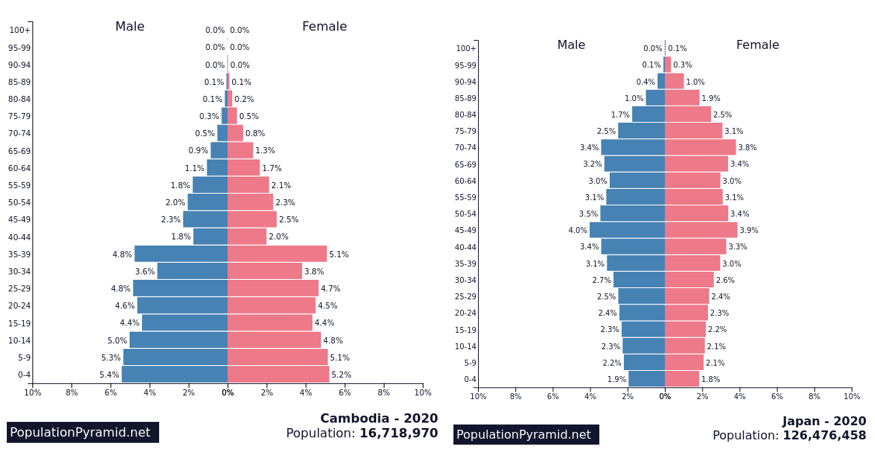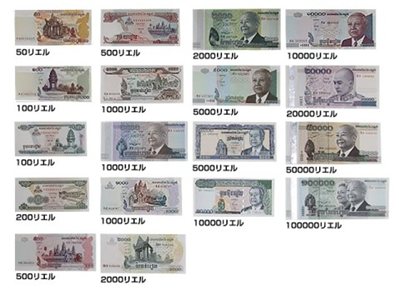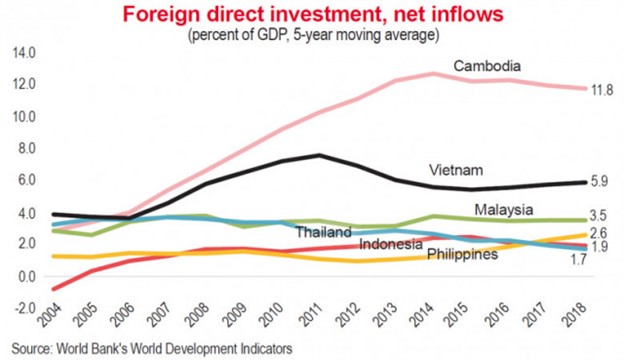Cambodia is located in the center of ASEAN
The official name of Cambodia is “The Kingdom of Cambodia”, a country located on the Indochina Peninsula in Southeast Asia, and is famous for its World Heritage Site Angkor Wat. Cambodia is located in the center of 10 ASEAN countries bordering Laos, sandwiched between Thailand and Vietnam.
Phnom Penh, the capital of Cambodia, is located right in the center of Bangkok, the capital of Thailand, and Ho Chi Minh, the largest city in Vietnam, and these cities are connected by roads.
The location is good as it has the Mekong River and faces the South China Sea. The area is about half that of Japan (181,035 km2), the time difference from Japan is 2 hours. There is no earthquake and a very low risk of natural disasters. Cambodia became completely independent of France in 1953. Overcoming the turmoil of the past, it is now stable in politics under a constitutional monarchy.

Cambodian language is Khmer
The official language and native language of Cambodia is “Khmer”. The characters are “Khmer characters” and the grammar is the same as English. It is also called Cambodian, but it is officially Khmer, and the correct name for Cambodians is Khmer. Most Cambodian people are Buddhist, friendly, polite, and devoted to their families.
Local people talk in Khmer, but usually, they can speak English wherever they go. Airports, hotels, banks, tourist destinations, taxis, tuk-tuk, restaurants, etc. can communicate in English, and they can speak English far more than neighboring countries such as Vietnam and Thailand, which have higher GDP than Cambodia. Signs and menus are also written in English along with Khmer.
Cambodia is full of young people
Cambodia has a population of about 16.5 million, and about half of the population is under 30 years old, making it a very young country. The clean pyramid-shaped population distribution is 60% or more of the working population, 30% of the young, and 9% or less of the elderly. In Japan, the average age is 45 years old, and the ratio of people aged 65 and over is 28.4%. Cambodia’s population growth rate is 1.4% per year, and it is said that the population explosion has just begun and is said to continue until 2045.

US dollars can be used in Cambodia
In Cambodia, the home currency Riel (KHR) and the US dollar (USD) are compatible. It is calculated as about 4000 Riel = 1 US dollar. Now, about 90% of the distribution amount is in US dollars, and the US dollar rate in deposit accounts is about 95%. Even for small amounts such as when riding a tuk-tuk or shopping at a food stall, you can use US dollars, and cashless payments are progressing.
Exchange from Japanese yen is generally converted to US dollars. Currency exchange offices and banks in the city have good rates, and it is unlikely that you will be given a large amount of Riel. There is also a service called foreign currency delivery that you can apply via the Internet or telephone.
In everyday life, there are many occasions when Riel is used as a sub-currency for the US dollar (instead of coins). You will receive Riel banknotes for changes of 1 USD or less, so be sure to familiarize yourself with Riel banknotes.
There are more than 20 types of officially issued banknotes in the home currency Riel (KHR), but only the 18 types are actually in circulation. The Japanese flag is printed on the 500 Riel.
50, 100 (2 types), 200, 500 (2 types), 1000 (3 types), 2000 (2 types),5000 (2 types), 10,000 (2 types), 20,000, 50,000, 100,000 Riel
There are 4 types of Riel coins, but they are not actually in circulation. As for coins, There are no US dollar cent coins in circulation, So both Riel and US dollars are banknotes only. You don’t need a coin wallet in Cambodia.

One of the highest economic growth in Asia
In Cambodia, the GDP growth rate has remained at a high level of 7% every year, and the labor force, purchasing power, and consumption are steadily increasing. This is one of the highest growing events in Asia. Japan is 0.3% (2018). Many foreign companies have entered the Cambodian market, reflecting rapid economic growth and stable political conditions.
Cambodia, which accepts foreign investment widely, has low foreign exchange risk even from a foreign perspective, and its potential as an investment destination is attractive as an investment destination, and it can be said that it is a factor that promotes economic growth.

Communication Situation in Cambodia
Online businesses, app services and cashless payments are everywhere in Cambodia. Free Wi-Fi is available from local restaurants to the interior of the congress building, and the environment is in place in Phnom Penh and other local cities. Cambodia became the first country in the world in 1993 to have more mobile phone subscribers than fixed-line subscribers. (International Telecommunication Union Statistics)Even if electricity is not drawn in rural areas, more than 80% of people in rural areas have mobile phones because they use them for work and contact with their families. Mobile phones accounted for 118% (2018), landlines accounted for 0.84% (2017), and the Internet accounted for 75% (2018).

In Japan, monthly charges for mobile phones are generally postpaid, but in Cambodia, prepaid payments are the mainstream. If you buy a SIM card for a few dollars, 1GB of data communication can be charged for about $ 3. It is an easy-to-understand system that makes communication impossible when it is used up, so we recommend that you purchase it when you come to the site.
There is no problem charging your computer or smartphone. The shape of the outlet in Cambodia is generally A type and C type, and most of them are dual-purpose types that both can be plugged in. Since the Japanese power plug is A-type, it can be plugged in as it is without a converter. The voltage in Cambodia is 220V, which is higher than the voltage in Japan, 100V, so a transformer is required when using Japanese electrical products. Electrical appliances labeled “INPUT: 100-240V”, such as chargers for personal computers and smartphones, can be used in Cambodia without a transformer.
Medical in conditions Cambodia
Considering the ratio of Japanese residence oversea, Cambodia have more Japanese doctors than other countries. In Cambodia (Phnom Penh), there are several medical institutions where Japanese doctors and Japanese nurses are stationed, and overseas travel insurance is also applied. There are several Japanese specialists, hospitalization services, Japanese medicines, Japanese ophthalmology and dentistry, also some hospitals provide vaccinations and emergency response.
Since we can handle everything from reception to medical treatment in Japanese, the dissatisfaction factor that there are few hospitals with Japanese doctors is considered to be relatively low in Cambodia.
Traffic conditions in Cambodia
Taxi is not very popular in Cambodia, and it is common to use tuk-tuk and ride-hailing apps such as PassApp and Grab. Many motorcycles run locally. In Cambodia, even foreigners do not need a license if they have a motorcycle of 125CC or less. You can drive a car or a large motorcycle with an “international driver’s license”, and you can renew your license in Cambodia for long-term stays.
In Cambodia, you cannot drive a motorcycle with a car license, so you will need to obtain two types of licenses.
Hotels in Cambodia
Cambodia has a variety of hotels, from guesthouses popular with backpackers to 5-star luxury hotels. Some guesthouses are run by Japanese companies for around $ 5 to $ 15 per night. Mid-range hotels cost around $ 20- $ 70, and there are a variety of business hotels that serve a Japanese breakfast. Of course, there are luxury 5-star hotels in Cambodia, which continue to develop economically, and the price is about 100 to 300 dollars per night. There are also world-famous hotels, the Hyatt Hotel and the Marriott Group Courtyard Hotel. The Shangri-La Hotel is currently under construction.
Housing Expense in Cambodia
Rents in Cambodia are high in prime locations, but they are considerably cheaper in the suburbs. For a one-bedroom property in the suburbs with air conditioning and a shower, the rent is the cheapest, about $ 200 a month. On the other hand, condominiums that are well-located and have a certain amount of furniture and home appliances, and serviced apartments with a gym and pool are priced at around $ 500 to $ 1000 per month. It costs about $ 2000 a month for 2 bedrooms and about $ 3000 a month for 3 bedrooms.
Cambodian utility bill
Electricity charges in Cambodia are about 1500 Riel (about 40 yen) per kilowatt. The electricity price in Japan is around 30 yen per kilowatt, so the electricity bill is higher than in Japan. The electricity self-sufficiency rate is rising with economic growth, but the reason is that we are still importing electricity from neighboring countries.
The initial cost of gas in Cambodia is about $ 60, but after that, it is only for refilling and it is about $ 15 to $ 20 per 15 kg. Once refilled, it lasts for about 3 months, which gives the impression that it is cheaper than in Japan.
The water charge in Cambodia is about 1500-2000 Riel (about 40-54 yen) per 1 ㎥The average water charge in Japan is about 160 yen per 1 ㎥ , so the water charge in Cambodia is very cheap compared to Japan. Assuming that the average monthly water usage for living alone is 8㎥, the monthly water charge is about 14,000 riel (about 375 yen). For rent, there are many properties where the water bill is included in the rent.
Regarding drinking water, it has become common for Cambodian households to install a water server. Buy a server for about $ 100 and set a 5L bottle. You can buy a bottle for about $ 1 each. However, only in Phnom Penh, the capital of Cambodia, the water supply improvement project was successful with the support of Japan’s JICA, and the water quality is such that the water drawn from the tap can be drunk as it is. The business started in the ’90s, but the quality of water services is still high. It is natural for Japanese people, but if you have visited Southeast Asia, you can see how epoch-making this is.